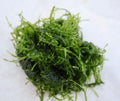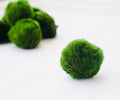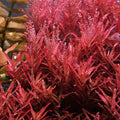Mystery Snail Diet and Habitat
A Mystery Snail seems to be comfortable in a landscaped aquarium. It is a scavenger, and living plants never allow a tank to get "overly clean."

There is almost always a plentiful source of food due to the vegetation. Snails feed on plant matter that has been shed on the tank bottom. This source's waste and debris may be fed to the Mystery Snail.
A Mystery Snail diet also contains a broad variety of other naturally occurring food in a tank. Soft filmy algae that collect on slow growing plant leaves, aquarium glass, and other hard surfaces may be favorite natural food sources.
They frequently discover algae sources growing on aquarium glass just beneath the surface of the gravel. They will sometimes dig to reach the algae. Supplements and blanched vegetables: In addition to naturally occurring food sources, a Mystery Snail diet should contain mixtures of bottom feeder pills, pellets, fish flakes, and algae wafers to assist offer a balanced diet.
A Mystery Snail diet may include cleaned soft blanched veggies like as green zucchini squash, leaf lettuce, and iceberg lettuce in addition to store-bought food. Because each snail is unique, experiment with various veggies to determine what works best. Remove a snail from the aquarium if it is not interested in a vegetable or food supplement after a day or two. Leaving uneaten food in the tank may easily lead to water quality concerns.
Plants that are hardy work well.
A Word on Mystery Snails and Live Plants: According to some hobbyists, Mystery Snails will consume live aquarium plants. Because the phrase "Mystery Snail" is often used loosely in pet retailers, it's difficult to tell whether a certain snail will eat live plants.
Other criteria include the sort of plants in the tank and how well the snail is nourished. Mystery Snails that are provided a well-balanced diet may be less inclined to devour plants until they are damaged.
If a Mystery Snail is interested in nibbling away at plants, robust, resilient hard-leaf plants like Anubias Barteri should be less of a problem. Soft fragile plants, such as floating Salvinia, on the other hand, may be more likely to be eaten. Keeping a supply of floating Salvinia in the tank may be the plant that a snail chooses above the other plants. Because various hobbyists have varied experiences with Mystery Snails and plants, it is best to consult the shop clerk before purchasing.
Temperament and Behavior of Mysterious Snails
A Mystery Snail is placid and non-aggressive by nature, preferring a serene aquatic habitat and pleasant tank mates. Mystery Snails lack the ability to fight other tank residents and rely only on their operculum and shell for defense against aggressors.
A Mystery Snail may be extremely busy when the tank lights are turned on, moving about the aquarium looking for food, fascinating areas to investigate, or a calm spot to relax. When the tank lights are turned off, a Mystery Snail may be highly active, eating at night in full darkness. A Mystery Snail may sometimes stretch its siphon and move to the surface shortly after the tank lights go off to obtain some air. And, as busy as a Mystery Snail may be, it is not unusual for it to remain still and look inert for extended periods of time.
Mystery Snails are often regarded to be sluggish moving animals. This is, for the most part, correct. However, Mystery Snails may be spotted traveling quite swiftly over aquarium glass at times.
Mystery Snails have also been seen climbing to the tops of tanks near the water's surface, only to abruptly release go of the surface and free fall to the tank bottom. When this free fall happens, they sometimes release a few of big air bubbles from beneath their shells on the way down.
Dead Snails & Mysterious Snail Lifespan
A Mystery Snail lives for approximately a year. If the water conditions are favorable and the snail is lucky, the snail's life span may be extended. It's worth noting one Mystery Snail longevity issue: it's fairly uncommon for a Mystery Snail to perish quickly after being put to a tank. This rapid mortality might be due to changes in water conditions or stress from being carried from the shop.
Dead Mystery Snail: Just like other freshwater snails, a dead Mystery Snail is easy to recognize. The snail's behavior is an excellent predictor. If the Mystery Snail has been floating in the water for an unusually long period of time, is immobile on the tank bottom, is upside down, or has expanded out of its shell, carefully remove it using a fish net.
Dead snails have a strong, repulsive odor. If there is a strong decaying odor, the snail is dead and should be removed from the tank. If the stink is gone, replace the snail in the tank right-side up.
If the snail continues in that posture for an extended period of time, check for the strong odor again, since the snail may be dying. To minimize water quality issues like as Ammonia spikes, a dead Mystery Snail should be removed from a tank as soon as possible.
Peaceful Mystery Snail Tank Mates
Tank mates for the Mystery Snail are quiet, placid, non-aggressive freshwater community tank fish. Freshwater shrimp such as Bamboo Shrimp, Vampire Shrimp, Amano Shrimp, Ghost Shrimp, and Red Cherry Shrimp may be tank mates.
Other freshwater snails to consider are Nerite Snails, Ramshorn Snails, Ivory Snails, Trumpet Snails, and Gold Inca Snails. Regular peaceful communal tank fish, as well as bottom feeders and algae eaters like Cory Cats and Otocinclus Catfish, might be ideal selections for fish.
Avoid goldfish and harsh roughens such as aquarium crayfish, Striped Convicts, Jack Dempsey, Oscars, and other cichlids. They could go for a Mystery Snail. Tough customers can yank off the snail's eyes, tentacles, or both. Worse, they can consume the Mystery Snail whole.
As usual, if you have any issues regarding tank mates and compatibility, check with the shop clerk to see whether a species would make excellent tank mates for a Mystery Snail.
















